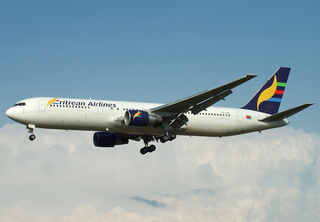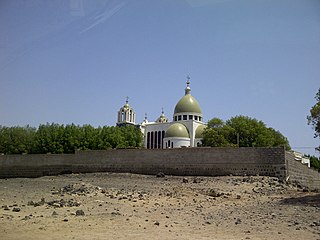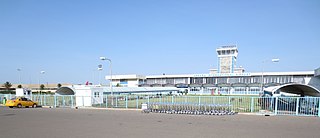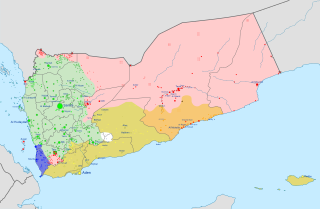
The Djibouti Armed Forces are the military forces of Djibouti. They consist of the Djiboutian National Army and its sub-branches the Djiboutian Air Force and Djiboutian Navy. As of 2018, the Djibouti Armed Forces consists of 20,470 ground troops, which are divided into several regiments and battalions garrisoned in various areas throughout the country. The Djibouti Armed Forces are an important player in the Bab-el-Mandeb and Red Sea.

Transport in Eritrea includes highways, airports and seaports, in addition to various forms of public and private vehicular, maritime and aerial transportation.

The Yemeni Armed Forces are the military forces of the Republic of Yemen. They include the Yemeni Army, Yemeni Navy and the Yemeni Air Force. Since the start of the current civil war in 2014, the armed forces have been divided; at first between loyalists of the former president Ali Abdullah Saleh and pro-Yemeni government forces of president Abdrabbuh Mansour Hadi; as of 2024, between the internationally recognized Presidential Leadership Council (PLC), and the Houthi-led Supreme Political Council (SPC). Per the constitution, the President of Yemen serves as the commander-in-chief. Currently, the presidency and supreme command of the armed forces is disputed between Rashad al-Alimi, Chairman of the PLC, and Mahdi al-Mashat, chairman of the SPC. Before the civil war, the united military was headquartered in the country's capital, Sana’a.

Zayed International Airport, also known as Abu Dhabi International Airport, is the primary international airport serving Abu Dhabi, the capital of the United Arab Emirates (UAE). It is the second busiest airport in the UAE after Dubai International Airport, one of the busiest airports in the Middle East and is the hub for Etihad Airways as well as an operating base for Wizz Air Abu Dhabi and Air Arabia Abu Dhabi.

Assab or Aseb is a port city in the Southern Red Sea Region of Eritrea. It is situated on the west coast of the Red Sea. Languages spoken in Assab are predominantly Afar, Tigrinya, and Arabic. After the Italian government took control of the port in 1882, it laid the foundations for the formation of the colony of Italian Eritrea, which became the independent country of Eritrea following its independence from Ethiopia in the 1990s.
Silk Way Airlines is an Azerbaijani private cargo airline with its head office and flight operations at Heydar Aliyev International Airport in Baku. It operates freight services to Asia, the Middle East and Europe, as well as services for government and non-governmental organisations. The airline is part of the Silk Way Group.

Canadian Forces Base Comox, commonly referred to as CFB Comox or 19 Wing, is a Canadian Forces Base located 2.5 nautical miles north northeast of Comox, Vancouver Island, British Columbia. It is primarily operated as an air force base by the Royal Canadian Air Force (RCAF) and is one of two bases in the country using the CP-140 Aurora anti-submarine/maritime patrol and surveillance aircraft. Its primary RCAF lodger unit is 19 Wing, commonly referred to as 19 Wing Comox.

Marib is the capital city of Marib Governorate, Yemen. It was the capital of the ancient kingdom of Sabaʾ, which some scholars believe to be the ancient Sheba of biblical fame. It is about 120 kilometres east of Yemen's modern capital, Sanaa, and is in the region of the Sarawat Mountains. In 2005 it had a population of 16,794. However, in 2021, it had absorbed close to a million refugees fleeing the Yemeni Civil War.

Asmara International Airport is the international airport of Asmara, the capital of Eritrea. It is the country's largest airport and the only one receiving regularly scheduled services as of 2017.
Abha International Airport is an airport in Abha, the capital of 'Asir Province in Saudi Arabia.

Aden International Airport is an international airport in Aden, Yemen and the oldest airport in the Arabian peninsula. Prior to its use as a civil air facility, the aerodrome was known as RAF Khormaksar, which opened in 1917 and closed as an RAF station in 1967. In the 1970s and 1980s it was both a civilian airport and a Soviet Naval Aviation base. It continues to be used for military purposes by the Yemeni Air Force.
The Eritrean Air Force (ERAF) is the air service branch of the Eritrean Defence Forces.

The Ethiopian Navy, known as the Imperial Ethiopian Navy until 1974, is a branch of the Ethiopian National Defense Force founded in 1955. It was disestablished in 1996 after the independence of Eritrea in 1991 left Ethiopia landlocked. In 2019, the Ethiopian Navy was re-established based in Bahir Dar, Amhara region, near Lake Tana.

The United Arab Emirates has quite a close and friendly relationship with the US, being described as the United States' best counter-terrorism ally in the Gulf by Richard A. Clarke, the U.S. national security advisor and counter-terrorism expert. In terms of defense, the United Arab Emirates Armed Forces has been nicknamed "Little Sparta" by United States Armed Forces generals and former U.S. Secretary of Defense Jim Mattis for its active role against extremists in the Middle East. The United Arab Emirates also hosts the only United States border preclearance in the Middle East. Both countries are members of the I2U2 Group, which was established in 2021.

Saudi Arabia and the United Arab Emirates (UAE) are neighbouring countries in the Middle East and Persian Gulf region, and share extensive political and cultural ties. Saudi Arabia maintains an embassy in Abu Dhabi and a consulate in Dubai of the UAE, while the UAE has an embassy in Riyadh and a consulate in Jeddah, Saudi Arabia.

The Yemeni civil war is an ongoing multilateral civil war that began in late 2014 mainly between the Rashad al-Alimi-led Presidential Leadership Council and the Mahdi al-Mashat-led Supreme Political Council, along with their supporters and allies. Both claim to constitute the official government of Yemen.

On 26 March 2015, Saudi Arabia, leading a coalition of nine countries from West Asia and North Africa, launched an intervention in Yemen at the request of Yemeni president Abdrabbuh Mansur Hadi, who had been ousted from the capital, Sanaa, in September 2014 by Houthi insurgents during the Yemeni Civil War. Efforts by the United Nations to facilitate a power sharing arrangement under a new transitional government collapsed, leading to escalating conflict between government forces, Houthi rebels, and other armed groups, which culminated in Hadi fleeing to Saudi Arabia shortly before it began military operations in the country.
This is a list of aviation-related events from 2016.
This timeline of the Tigray War is part of a chronology of the military engagements of the Tigray War, a civil war that began in the Tigray Region of Ethiopia in early November 2020.
Events in the year 2021 in Eritrea.













